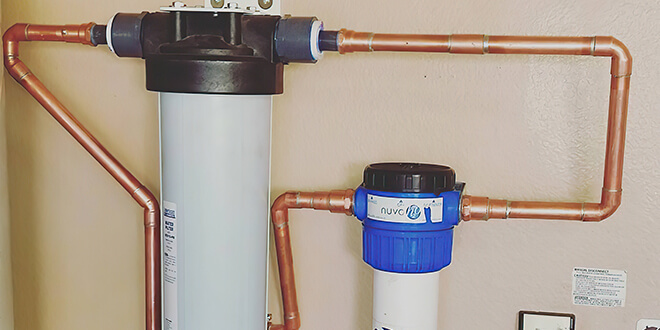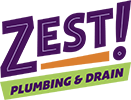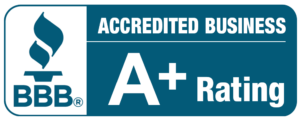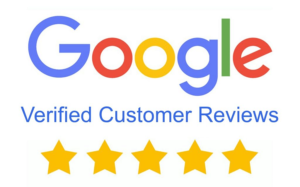If you’re interested in purifying your water to the greatest degree possible, a reverse osmosis (RO) filtration system may be the perfect fit for your needs. RO was originally developed to desalinate seawater. This installation offers outstanding results with multiple levels of filtration to capture nearly any contaminant that might be in your water. For the most powerful filtration possible, an RO system should be at the top of your wish list.

No matter your budget, we have a system that will fit your needs. If you are unsure which system is right for you, the experts at Zest Plumbing and Drain are here to explain how RO works, what it does to your water, and whether RO water is right for you.
What Is Reverse Osmosis?
RO is a water filtration system that uses a semi-permeable membrane to remove small particles and impurities from your water. Any contaminants that are larger than the membrane’s tiny pores are caught at this point in the filtration system. Many RO filters use a cross-flow system to clean the membrane naturally and continuously.
A cross-flow system is T-shaped with a semi-permeable membrane at the center. To visualize this, imagine that contaminated water enters from the left, hits the membrane, and emerges clean on the other side. The clean water then exits to the right and flows into your home. Just before the membrane, the cross-flow system features a second pipe that flows downward toward the drain. Water that doesn’t push through the membrane sweeps away the contaminants and carries them along to the drain.
It takes a pressure of 40 psi or greater to push water through the fine membrane of the RO system. This pressure keeps the water moving and can efficiently propel water through both pathways of the cross-flow setup.
In this process, the only things that can pass through the membrane are water molecules – contaminants are left behind.
How Does Reverse Osmosis Work?
A complete RO system typically includes a series of filters with filtration points both before and after the semi-permeable membrane described above. Before reaching this membrane, water typically passes through a sediment filter to capture large bits of sand or dirt and then a pre-carbon filter. The pre-carbon RO filter features activated carbon that captures positively charged ions while keeping compounds like chloramines and chlorine from passing through. This is especially important because chlorine can damage the delicate membrane filter, enlarging its pores and diminishing its effectiveness.
Some RO systems provide UV treatment at this point as well. UV light tackles living organisms such as bacteria. Not all RO systems include this feature. A UV treatment is usually only necessary for homes on well water or surface water.
The semi-permeable membrane that is the centerpiece of the RO system is the third point of filtration. This membrane serves to stop lead, fluoride, sodium, and other minerals that may have gotten through the previous filters.
Finally, water goes through a post-carbon RO filter. The post-carbon filter polishes the water, improving taste, eliminating odors, and enhancing quality. The post-carbon filter can capture volatile organic compounds, solvents, chemicals, and total organic carbon (TOC).
Common Contaminants Removed by RO
Reverse osmosis is an effective way to remove many different types of contaminants from your water supply, including:
- Dissolved minerals
- Bacteria
- Viruses
- Salt
- Fluoride
- Lead
- Arsenic
- Chlorine
However, reverse osmosis systems are ineffective at removing dissolved gases or organic compounds from your water. For that reason, most RO systems will also have a carbon filter as part of their set-up to address these additional contaminants.
What Are the Benefits of an RO System?
RO water is among the highest quality water you can get. Even at a residential grade, RO systems can remove as much as 99% of harmful contaminants, such as lead and asbestos. An RO filter is also effective at stopping salt, dirt, chlorine, and microorganisms. The semi-permeable membrane at the heart of the system has pores that measure only 0.0001 microns. This is small enough to remove substances that have already dissolved in the water.
An RO system is a great way to cut down on plastic consumption if you’re currently purchasing bottled water. Many Americans don’t realize that the EPA’s regulations for tap water are more strict than the FDA’s requirements for bottled water. This means that most people are better off getting water from the tap. If your tap water doesn’t taste quite right, an RO system can take the flavor and quality to the next level.
RO water is also optimal for cooking, as it lacks the minerals and fluoride that you’ll get from the tap. While these may not harm your health, they do interact with other elements and may change the flavor and quality of your food.
If you have an aquarium, RO water is ideal for raising delicate fish, coral, or other aquatic pets. These creatures can be highly sensitive to minor contaminants.
System Maintenance and Lifespan
With proper maintenance, your reverse osmosis system can last for many years – up to 20 years in some cases. To keep your system running smoothly, it’s important to replace your filters regularly and properly clean all of the parts regularly. Doing so will help ensure that your system continues to run effectively and efficiently for many years.
Overall, reverse osmosis is an effective filtration method that can remove many contaminants from your water supply. While RO systems require regular maintenance to keep them running effectively, they can last many years with proper care.
What To Consider When Getting an RO System
An RO system is a significant investment, so you want to make sure that you purchase wisely. Look for a well-known brand with excellent reviews. This isn’t the time to purchase a knock-off from a name you’ve never heard of. The RO installation must feature reliable, quality components.
RO systems require regular care and maintenance. Before you schedule installation, make sure you’re familiar with everything the system needs. Do you have an affordable source for compatible replacement filters? Are you in contact with an expert plumbing company that can handle maintenance and repairs? Don’t wait until your filter has failed or the system isn’t working to identify key vendors for these easily anticipated needs.
Finally, consider whether an RO system is the right fit for your family. This is an extremely efficient filtration system. Some homeowners feel that the water tastes flat without the beneficial minerals that are usually present. If you’re seeking a standard level of filtration, an activated carbon filter may be sufficient.
Book Your RO Appointment in Scottsdale, Arizona, Today
If you’re interested in enhancing the water quality in your home, our team at Zest Plumbing and Drain in Scottsdale can help. We offer installation, maintenance, and repair services for a variety of water filtration systems, including RO solutions. We will consider your water quality, budget, and other factors to help you select the best system for your home or office. Once you have chosen the perfect system, our team of experts will install it for you. We will ensure that it is installed correctly and works properly.
Contact Zest Plumbing and Drain today if you are ready to experience the benefits of reverse osmosis in Scottsdale, AZ. We would be happy to answer any questions and help you select the perfect system for your needs. We look forward to serving you.
Dial (480) 448-5750 now!




